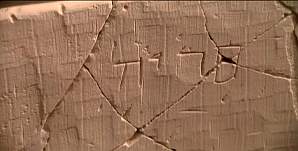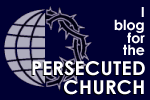Dicovery Channels "Jesus Tomb" FLIP FLOPS!

Oh! Of course! This clearly says "Mary Magdalene"
I have my suspicions that the Discovery Channel seems to be more and more Anti-Christian...but those are my opinions. What is obvious is that Discovery promotes their documentaries in the tone that their documentary was "so-well-founded in scientific fact you are a buffoon if you don't believe it". One of these marketing bombardments began on the RECENT documentary on the "miraculous" discovery of Jesus' tomb which was actually discovered OVER 20 years ago. Cameron and his cronies stood vehemently behind all of their irrefutable scientific evidence and when their own researchers and scientists began changing their statements....what does Discovery do? They do nothing to let their audience know about the changes! Now that's a great example of UN responsible reporting and more foolish science. How many people saw the Great James Cameron's documentary and believed everything they said? Plenty...and really that is the audiences fault. Who's fault is it for deceiving people and making theory sound like fact?
The blame is on the Discovery Channel...
Notice that this article found below first appears in the Jerusalem Post. Would our mass media in the West devote time to print this article?
NO WAY!
Jesus tomb film scholars backtrack
By ETGAR LEFKOVITS
Several prominent scholars who were interviewed in a bitterly contested documentary that suggests that Jesus and his family members were buried in a nondescript ancient Jerusalem burial cave have now revised their conclusions, including the statistician who claimed that the odds were 600:1 in favor of the tomb being the family burial cave of Jesus of Nazareth, a new study on the fallout from the popular
documentary shows.
The dramatic clarifications, compiled by epigrapher Stephen Pfann of the University of the Holy Land in Jerusalem in a paper titled "Cracks in the Foundation: How the Lost Tomb of Jesus story is losing its scholarly support," come two months after the screening of The Lost Tomb of Christ that attracted widespread public interest, despite the concomitant scholarly ridicule.
The film, made by Oscar-winning director James Cameron and Emmy-winning Canadian filmmaker Simcha Jacobovici, prompted major criticism from both a leading Israeli archaeologist involved in the original dig at the site as well as Christian leaders, who were angered over the documentary contradictions of main tenets of Christianity.
But now, even some of the scholars who were interviewed for and appeared in the film are questioning some of its basic claims.
The most startling change of opinion featured in the 16-page paper is that of University of Toronto statistician Professor Andrey Feuerverger, who stated those 600 to one odds in the film. Feuerverger now says that these referred to the probability of a cluster of such names appearing together.
Pfann's paper reported that a statement on the Discovery Channel's Web site, which previously read "a statistical study commissioned by the broadcasters...concludes that the probability factor is 600 to 1 in favor of this being the tomb of Jesus of Nazareth and his family," in keeping with Feuerverger's statement, has been altered and now reads, "a statistical study commissioned by the broadcasters... concludes that the probability factor is in the order of 600 to 1 that an equally 'surprising' cluster of names would arise purely by chance under given assumptions."
Another sentence on the same Web site stating that Feuerverger had concluded it was highly probable that the tomb, located in the southeastern residential Jerusalem neighborhood of Talpiot, was the Jesus family tomb - the central point of the film - has also been changed. It now reads: "It is unlikely that an equally surprising cluster of names would have arisen by chance under purely random sampling."
Israeli archaeologists have said that the similarity of the names found inscribed on the ossuaries in the cave to the members of Jesus's family was coincidental, since many of those names were commonplace in the first century CE.
The film argues that 10 ancient ossuaries - burial boxes used to store bones - that were discovered in Talpiot in 1980 contained the bones of Jesus and his family. The filmmakers attempt to explain some of the inscriptions on the ossuaries by suggesting that Jesus was married to Mary Magdalene, and that the couple had a son, Judah.
One of the ossuaries bears an inscription reading "Yeshua son of Yehosef" or "Jesus son of Joseph;" a second reads "Mary;" a third is a Greek inscription apparently read by one scholar as "Mary Magdalene;" while a fourth bears the inscription, "Judah, son of Jesus." The inscriptions are in Hebrew or Aramaic, except for the one in Greek.
But Shimon Gibson, who was part of the team that excavated the tomb two and half decades ago and who appeared in the film, is quoted in Pfann's report as saying he doubted the site was the tomb of Jesus
and his family.
"Personally, I'm skeptical that this is the tomb of Jesus and I made this point very clear to the filmmakers," Gibson is quoted as saying.
"We need much more evidence before we can say that the Talpiot tomb might be the family tomb of Jesus," he added.
In the film, renowned epigrapher Prof. Frank Moore Cross, professor emeritus of Hebrew and oriental languages at Harvard University, is seen reading one of the ossuaries and stating that he has "no real doubt" that it reads "Jesus son of Joseph." But according to Pfann, Cross said in an e-mail that he was skeptical about the film's claims, not because of a misreading of the ossuary, but because of the ubiquity of Biblical names in that period in Jerusalem.
"It has been reckoned that 25 percent of feminine names in this period were Maria/Miriam, etc. - that is, variants of 'Mary.' So the cited statistics are unpersuasive. You know the saying: lies, damned lies, and statistics," Cross is quoted as saying.
The paper also notes that DNA scientist Dr. Carney Matheson, who supervised DNA testing carried out for the film from the supposed Jesus and Mary Magdalene ossuaries, and who said in the documentary that "these two individuals, if they were unrelated, would most likely be husband and wife," later said that "the only conclusions we made were that these two sets were not maternally related. To me, it sounds like absolutely nothing."
Furthermore, Pfann also says that a specialist in ancient apocryphal text, Professor Francois Bovon, who is quoted in the film as saying the enigmatic ossuary inscription "Mariamne" is the same woman known as Mary Magdalene - one of the filmmakers' critical arguments - issued a disclaimer stating that he did not believe that "Mariamne" stood for Mary of Magdalene at all.
Pfann has already argued that the controversial inscription does not read "Mariamne" at all.
The burial site, which has been contested from the start by scholars and church officials alike, is some distance from the Church of the Holy Sepulchrr in the Old City, where many Christians believe Jesus's body lay for three days after he was crucified.
According to the New Testament, Jesus rose from the dead on the third day after his crucifixion, and an ossuary containing Jesus's bones - the explanations of the movie director notwithstanding - would contradict the core Christian belief that he was resurrected and then
ascended to heaven.
Technorati:us history,us-history,politics,christian history,christian-history,history,learn from mistakes
Labels: asinine
















